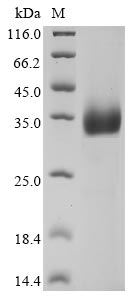Recombinant Bovine coronavirus Spike glycoprotein (S) is produced in a yeast expression system, spanning amino acids 314 to 634 of the protein. This partial protein carries a 6xHis tag at the C-terminus, which helps with purification and detection. The product shows purity levels exceeding 90% when assessed by SDS-PAGE, providing high-quality material for various research applications.
The Spike glycoprotein (S) of Bovine coronavirus appears to play a crucial role in how the virus enters host cells. It enables attachment to cell receptors and the subsequent fusion of viral and cellular membranes—a critical step in the viral life cycle. This protein has become a significant focus in research, helping scientists study virus-host interactions and develop therapeutic interventions.
Potential Applications
Note: The applications listed below are based on what we know about this protein's biological functions, published research, and experience from experts in the field. However, we haven't fully tested all of these applications ourselves yet. We'd recommend running some preliminary tests first to make sure they work for your specific research goals.
The protein is expressed in a yeast system, which supports native-like folding and partial post-translational modifications (PTMs)—critical for the bovine coronavirus Spike (S) protein fragment (314–634 aa). The C-terminal 6xHis tag minimally disrupts structure, and yeast’s eukaryotic machinery improves solubility compared to prokaryotic systems. However, no direct evidence confirms native secondary/tertiary structure (e.g., circular dichroism for disulfide bonds, thermal shift assays for stability). Yeast may not replicate mammalian-specific glycosylation or disulfide pairing, potentially altering conformation. The fragment’s biological role (e.g., receptor binding, fusion activity) is untested—yeast expression does not guarantee retention of native functional interfaces. Bioactivity (e.g., binding to bovine cell receptors) requires explicit validation.
1. Antibody Development and Characterization
This recombinant S fragment can serve as an immunogen for generating antibodies, but antibody specificity must be validated against native S—yeast folding may present non-native epitopes, leading to cross-reactivity. The His tag simplifies purification/immobilization for ELISA, but antibodies may not recognize the fragment in its native context (e.g., on viral particles).
2. Protein-Protein Interaction Studies
Pull-down assays using the His tag can identify interactors, but results depend on correct folding—yeast-expressed fragments may misfold, causing false positives. Identified partners must be validated via co-IP or functional assays to rule out artifacts. The fragment’s defined region (314–634 aa) supports domain-specific interaction mapping, but bioactivity (e.g., receptor binding) is unconfirmed.
3. Structural and Biochemical Analysis
This fragment supports preliminary biophysical studies (e.g., CD for secondary structure, DLS for stability) but cannot fully represent the native S protein. Yeast’s glycosylation profile differs from mammals, potentially affecting structural dynamics. Conclusions about folding or conformational changes must contextualize yeast-specific PTMs.
4. Comparative Coronavirus Research
This yeast-expressed fragment enables cross-species comparisons, but PTM differences (e.g., glycosylation) may confound results—bovine coronavirus S may fold differently than SARS-CoV-2 or MERS-CoV S. Evolutionary insights require complementary sequence/functional data to account for system biases.
Final Recommendation & Action Plan
This yeast-expressed bovine coronavirus S fragment (314–634 aa) is a viable tool for antibody development or preliminary interaction studies, but requires rigorous validation first, confirm folding via circular dichroism/thermal shift assays to rule out misfolding; second, validate bioactivity (e.g., receptor binding) using co-IP or cell-based assays. Optimize expression (e.g., co-express chaperones) to improve native folding. For structural studies, consider cleaving the His tag to reduce artifacts. If folding/bioactivity fails, switch to a mammalian system (e.g., HEK293 cells) to ensure mammalian-specific PTMs and native conformation—this fragment’s utility for functional studies depends on validating its structural integrity.






